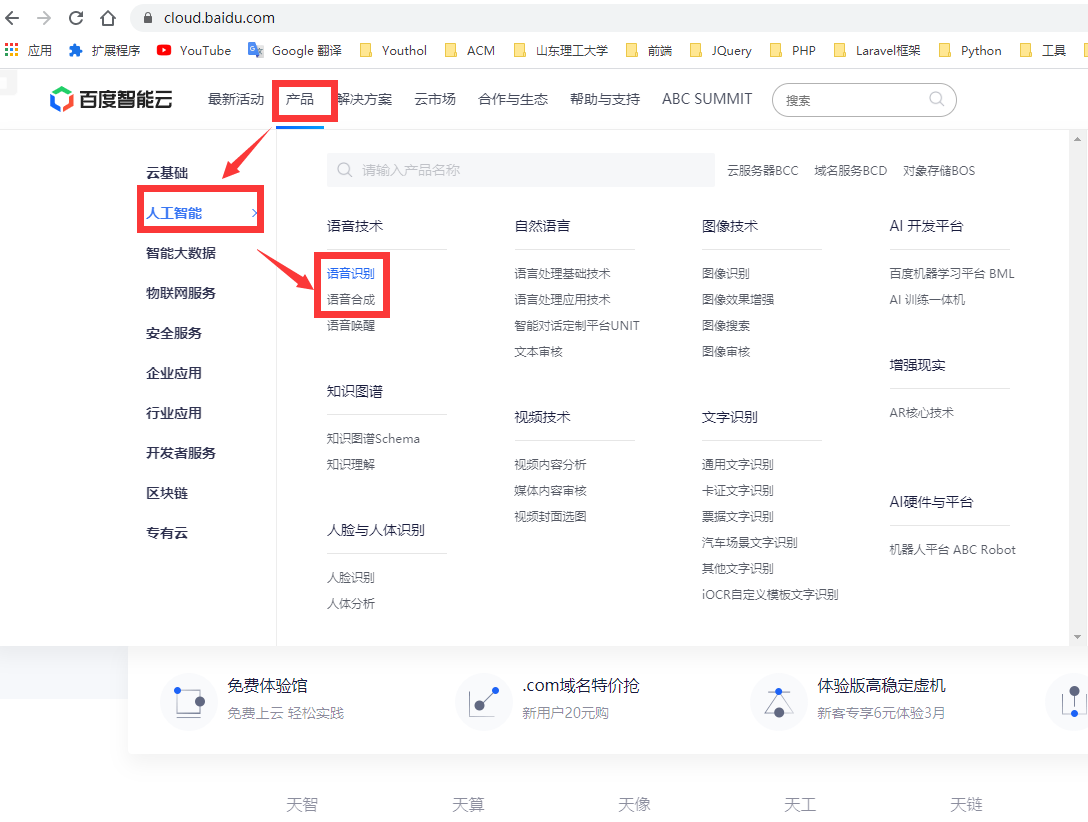Python智能语音机器人
先看效果视频 click here => https://www.yuque.com/docs/share/24f6227b-0785-4d90-a319-94bd0deaceab?
千万别看名字高大上,实际很简单,会简单使用Python调用API就行(手动滑稽)
主要使用的套餐如下:
Python模块:
Python基础 + pyAudio框架 + SpeechRecognition框架 + wave模块 +tqdm模块
应用平台:
百度AI开放平台 + 图灵机器人
主要思路:
利用Python的SpeechRecognition进行语音录入,Then发送到百度AI平台识别,Then将识别的信息发送到图灵机器人以获取对话内容,Then将返回的对话内容发送到百度AI平台传回TTS语音,Then用Python的pyAudio播放绕来绕去没绕晕了吧,嘿嘿
应用平台:
想了想还是先说这个吧~不然看下边的时候怪懵逼的~
这是百度AI开放平台 => https://ai.baidu.com/
去注册个账号,实名一下(反正免费的,实名了有好处~~~)
按照以下图片依次点击创建应用,默认就好 语音识别 (还有一个语音合成),创建完了后会有那些东西的~~~




这是百度他们平台的产品文档,以你们的聪明才智很轻松就明白了(一定要好好阅读) => https://cloud.baidu.com/doc/SPEECH/s/ijwvy5keu
这是GitHub上他们的一个示例,你要能看懂就去看看吧 => https://github.com/Baidu-AIP/speech-demo
这是图灵机器人 => http://www.turingapi.com/
还是老样子注册实名读产品文档~~~~
文档入口 => http://www.tuling123.com/help/h_cent_webapi.jhtml?nav=doc
Python 模块:
(我是封装到一个类里的,两个平台所需的一些东西分步说的时候没展示出来,最后会有一个总的)
主要使用SpeechRecognition的录音功能
安装:
pip install SpeechRecognitionLook here https://pypi.org/project/SpeechRecognition/
'''
调用speech_recognition模块录音方法,从系统麦克风拾取音频数据,
采样率为 16000(百度语音 Api 最高支持到 16k 的采样率)
Then将采集到的音频数据以 wav 格式保存在当前目录下的 recording.wav 文件中,
供后面的程序使用
'''
def recordBySr(self, rate=16000):
r = sr.Recognizer()
with sr.Microphone(sample_rate=rate) as source:
print("please say something")
audio = r.listen(source)
with open("recording.wav", "wb") as f:
f.write(audio.get_wav_data())百度语音对于SpeechRecognition录音的 识别
先look look参考文档(
我这蹩脚的英语又来了) = > http://xcx1024.com/ArtInfo/643201.html百度自己的一套Api
666
'''
将 SpeechRecognition 录制的音频格式为.wav文件使用Post方法上传上传至百度语音的服务,
返回识别后的json数据并抽取result的文本进行输出
'''
def recogByBaiduApi(self):
with open('recording.wav', 'rb') as f:
audio_data = f.read()
# 参数'dev_pid'普通话(支持简单的英文识别)
result = self.client.asr(audio_data, 'wav', 16000, {
'dev_pid': 1536,
})
result_text = result["result"][0]
print("you said: " + result_text)
return result_text重头戏来了,实现智能对话主要依靠图灵机器人的API
'''
请求图灵,获取聊天内容
'''
def tuLing(self, content):
# 图灵api
api = r'http://openapi.tuling123.com/openapi/api/v2'#文档推荐这个接口!!!
# userid = int(time.time())
# 创建post提交的数据
data = {
"perception": {
"inputText": {
"text": content
}
},
"selfInfo": {
"location": {
"city": "写你所在的城市",
"street": "你所在的路???"
}
},
"userInfo": {
"apiKey": "你个人的apiKey",
"userId": '你个人的userId',
}
}
# 转化为json格式
jsondata = json.dumps(data)
# 发起post请求
response = requests.post(api, data=jsondata)
# 将返回的json数据解码
robot_res = json.loads(response.content)
# 提取对话数据
print(robot_res["results"][0]['values']['text'])
robotRes = robot_res["results"][0]['values']['text']
return robotRes百度语音(TTS)对于图灵返回的文字进行语音合成
'''
发送请求,获取语音合成.wav
'''
def getBaiDuTts(self, text=""):
result = self.client.synthesis(text, 'zh', 1, {
'per': 4, # 发音人
'spd': 5, # 语速,取值0-15,默认为5中语速
'pit': 5, # 音调,取值0-15,默认为5中语调
'vol': 5, # 音量,取值0-9,默认为5中音量
'aue': 6, # 下载的文件格式, 3:mp3(default) 4: pcm-16k 5: pcm-8k 6. wav
})
if not isinstance(result, dict):
with open('back.wav', 'wb') as f:
f.write(result)播放百度语音(TTS)返回的合成语音
'''
播放百度AI合成语音
'''
def playAudio(self, path):
# define stream chunk
chunk = 1024
# open a wav format music
f = wave.open(path, "rb")
# instantiate PyAudio
p = pyaudio.PyAudio()
# open stream
stream = p.open(format=p.get_format_from_width(f.getsampwidth()),
channels=f.getnchannels(),
rate=f.getframerate(),
output=True)
# read data
data = f.readframes(chunk)
# print(data)
datas = []
# paly stream
while len(data) > 0:
data = f.readframes(chunk)
datas.append(data)
for d in tqdm(datas):
stream.write(d)
# stop stream (4)
stream.stop_stream()
stream.close()
# close PyAudio (5)
p.terminate()这里主要使用前面说的PyAudio跨平台音频I / O库,和tqdm模块,可以方便显示进程(简单说有个进度条)
网上对这个库的简介:
PyAudio为跨平台音频I / O库 PortAudio 提供 Python 绑定。使用PyAudio,您可以轻松地使用Python在各种平台上播放和录制音频,例如GNU / Linux,Microsoft Windows和Apple Mac OS X / macOS。
这个不是重点,而是在Windows平台上安装Python的一些库太令人头疼了,这个PyAudio库开始就卡住了我(手动泪奔)
解决方法(让我们少走一些弯路吧)
pip install pyaudio提示error: Microsoft Visual C++ 14.0 is required. Get it with “Microsoft Visual C++ Build Tools”: 此处省略一个链接
现在你需要到这个地址下载对应的whl https://www.lfd.uci.edu/~gohlke/pythonlibs/#pyaudio
PyAudio‑0.2.11‑cp37‑cp37m‑win_amd64.whl
cp37代表python版本号3.7,amd64代表64位
over后依照次序安装
pip install Twisted-18.7.0-cp36-cp36m-win_amd64.whl
pip install pyaudio对这两个来个知乎解释,嘿嘿~~~ https://zhuanlan.zhihu.com/p/71235612
最后贴上封装好的类
import json
import time
import wave
import string
import pyaudio
import requests
from tqdm import tqdm
from aip import AipSpeech
import speech_recognition as sr
class SmartChatRobot(object):
'''
Baidu Speech API
'''
APP_ID = '你自己的APP_ID'
API_KEY = '你自己的API_KEY'
SECRET_KEY = '你自己的SECRET_KEY'
client = AipSpeech(APP_ID, API_KEY, SECRET_KEY)
#url = 'http://fjx.com/api/test' # 忽略当时是参加一个比赛额外加的,自己写了个测试接口返回室内温度啥的~
'''
调用speech_recognition模块录音方法,从系统麦克风拾取音频数据,
采样率为 16000(百度语音 Api 最高支持到 16k 的采样率)
Then将采集到的音频数据以 wav 格式保存在当前目录下的 recording.wav 文件中,
供后面的程序使用
'''
def recordBySr(self, rate=16000):
r = sr.Recognizer()
with sr.Microphone(sample_rate=rate) as source:
print("please say something")
audio = r.listen(source)
with open("recording.wav", "wb") as f:
f.write(audio.get_wav_data())
'''
将 SpeechRecognition 录制的音频格式为.wav文件使用Post方法上传上传至百度语音的服务,
返回识别后的json数据并抽取result的文本进行输出
'''
def recogByBaiduApi(self):
with open('recording.wav', 'rb') as f:
audio_data = f.read()
# 参数'dev_pid'普通话(支持简单的英文识别)
result = self.client.asr(audio_data, 'wav', 16000, {
'dev_pid': 1536,
})
result_text = result["result"][0]
print("you said: " + result_text)
return result_text
'''
请求图灵,获取聊天内容
'''
def tuLing(self, content):
# 图灵api
api = r'http://openapi.tuling123.com/openapi/api/v2'
# userid = int(time.time())
# 创建post提交的数据
data = {
"perception": {
"inputText": {
"text": content
}
},
"selfInfo": {
"location": {
"city": "淄博",
"street": "新村路"
}
},
"userInfo": {
"apiKey": "你自己的",
"userId": '你自己的',
}
}
# 转化为json格式
jsondata = json.dumps(data)
# 发起post请求
response = requests.post(api, data=jsondata)
# 将返回的json数据解码
robot_res = json.loads(response.content)
# 提取对话数据
print(robot_res["results"][0]['values']['text'])
robotRes = robot_res["results"][0]['values']['text']
return robotRes
'''
发送请求,获取语音合成.wav
'''
def getBaiDuTts(self, text=""):
result = self.client.synthesis(text, 'zh', 1, {
'per': 4, # 发音人
'spd': 5, # 语速,取值0-15,默认为5中语速
'pit': 5, # 音调,取值0-15,默认为5中语调
'vol': 5, # 音量,取值0-9,默认为5中音量
'aue': 6, # 下载的文件格式, 3:mp3(default) 4: pcm-16k 5: pcm-8k 6. wav
})
if not isinstance(result, dict):
with open('back.wav', 'wb') as f:
f.write(result)
'''
播放百度AI合成语音
'''
def playAudio(self, path):
# define stream chunk
chunk = 1024
# open a wav format music
f = wave.open(path, "rb")
# instantiate PyAudio
p = pyaudio.PyAudio()
# open stream
stream = p.open(format=p.get_format_from_width(f.getsampwidth()),
channels=f.getnchannels(),
rate=f.getframerate(),
output=True)
# read data
data = f.readframes(chunk)
# print(data)
datas = []
# paly stream
while len(data) > 0:
data = f.readframes(chunk)
datas.append(data)
for d in tqdm(datas):
stream.write(d)
# stop stream (4)
stream.stop_stream()
stream.close()
# close PyAudio (5)
p.terminate()
'''
发送API请求,查询最新温度,PHP实现
'''
def QrIndrTemp(self):
res = requests.get(self.url)
data = res.json()
current = data[1]["temperature"]
return current
'''
检测输入语音的关键字
'''
def find_string(self, s, t):
try:
str.index(s, t)
return True
except(ValueError):
return False
'''
条件判断函数,根据关键字判别,决定是否激发其他功能 这个除了谈话结束别的忽略,原因同上
'''
def cdJudument(self, result_text):
interruptStr = "谈话结束"
inquireTem = "查询一下室内温度"
if interruptStr in result_text:
res = self.find_string(result_text, interruptStr)
if res:
end = "那我就和你说拜拜啦"
self.getBaiDuTts(end)
self.playAudio("back.wav")
exit(0)
else:
pass
elif inquireTem in result_text:
res1 = self.find_string(result_text, inquireTem)
if res1:
current = self.QrIndrTemp()
currents = "当前最新查询到的室内温度为" + str(current) + "摄氏度"
self.getBaiDuTts(currents)
self.playAudio("back.wav")
time.sleep(1)
else:
pass
else:
robotRes = self.tuLing(result_text)
self.getBaiDuTts(robotRes)
self.playAudio("back.wav")
time.sleep(1)
def dialogue(self):
while True:
# 输入对话内容
self.recordBySr()
result_text = self.recogByBaiduApi()
self.cdJudument(result_text)
if __name__ == '__main__':
test = SmartChatRobot()
test.dialogue()

还不快抢沙发